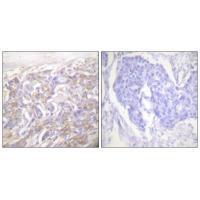
| WB | 咨询技术 | Human,Mouse,Rat |
| IF | 咨询技术 | Human,Mouse,Rat |
| IHC | 1/50-1/200 | Human,Mouse,Rat |
| ICC | 1/100-1/500 | Human,Mouse,Rat |
| FCM | 咨询技术 | Human,Mouse,Rat |
| Elisa | 咨询技术 | Human,Mouse,Rat |
| Aliases | CD120a; TBPI; TNF-RI; TNFAR; TNFR1 |
| Entrez GeneID | 7132; |
| WB Predicted band size | 50kDa |
| Host/Isotype | Rabbit IgG |
| Antibody Type | Primary antibody |
| Storage | Store at 4°C short term. Aliquot and store at -20°C long term. Avoid freeze/thaw cycles. |
| Species Reactivity | Human,Mouse,Rat |
| Immunogen | Synthesized peptide derived from Internal of human TNF receptor-1. |
| Formulation | Purified antibody in PBS with 0.05% sodium azide. |
+ +
以下是3-4篇关于 **TNF Receptor-1(TNFR1)抗体** 的参考文献及其简要摘要:
---
1. **文献名称**:*Crystal structure of the soluble human 55 kd TNF receptor–human TNFβ complex*
**作者**:H. Hsu et al.
**摘要**:该研究解析了人TNFR1胞外段与TNF-β的复合物晶体结构,揭示了TNFR1与配体结合的关键结构域,为设计靶向TNFR1的抗体或抑制剂提供了分子基础。
---
2. **文献名称**:*Targeting death and decoy receptors of the tumour necrosis factor superfamily*
**作者**:A. Ashkenazi
**摘要**:综述了TNFR家族(包括TNFR1)在疾病中的作用,重点讨论了通过抗体或工程化蛋白靶向TNFR1以调控凋亡或炎症通路的治疗策略。
---
3. **文献名称**:*Structure of tumour necrosis factor-alpha complexed with its type 1 receptor*
**作者**:D.W. Banner et al.
**摘要**:通过X射线晶体学阐明了TNF-α与TNFR1的结合模式,明确了抗体可能干预的位点,为开发阻断TNF-TNFR1相互作用的中和抗体奠定基础。
---
4. **文献名称**:*Antibody-mediated targeting of TNFR1 enhances antitumor activity of CAR-T cells in solid tumors*
**作者**:C.A. Vaine et al.
**摘要**:研究利用抗TNFR1抗体联合CAR-T细胞疗法,显示其在实体瘤中增强T细胞浸润和抗肿瘤活性的潜力,为TNFR1抗体的临床应用提供了新方向。
---
以上文献涵盖结构生物学、治疗策略及转化医学研究,可根据具体需求进一步查阅。
Tumor necrosis factor receptor-1 (TNFR1), also known as CD120a or TNFRSF1A, is a transmembrane protein that belongs to the TNF receptor superfamily. It plays a central role in mediating inflammatory, apoptotic, and immune-regulatory signals triggered by its ligand TNF-α. TNFR1 contains a conserved cytoplasmic death domain that enables recruitment of adaptor proteins like TRADD, initiating downstream signaling cascades, including NF-κB and MAPK pathways, which regulate cell survival, inflammation, or apoptosis depending on cellular context. Dysregulation of TNFR1 signaling is linked to autoimmune diseases, cancer, and neurodegenerative disorders.
Antibodies targeting TNFR1 are designed to modulate its activity for therapeutic or research purposes. Agonistic antibodies can mimic TNF-α binding, promoting receptor clustering and apoptosis in certain cancer cells. Conversely, antagonistic antibodies block TNF-α interaction, suppressing pro-inflammatory signaling—a strategy explored for conditions like rheumatoid arthritis or sepsis. Some antibodies also stabilize TNFR1 conformations to bias signaling toward specific pathways (e.g., favoring cell death over survival signals). Challenges include balancing therapeutic effects with potential off-target consequences, as TNFR1 has dual roles in both promoting and limiting inflammation. Current research focuses on engineering bispecific antibodies or combining TNFR1-targeting agents with other therapies to enhance specificity and efficacy. These antibodies are vital tools for dissecting TNFR1 biology and developing treatments for TNF-driven pathologies.
×